January 25, 2019
Air Date: January 25, 2019
FULL SHOW
SEGMENTS

Climate Migrant Caravans
View the page for this story
Toward the end of 2018, Central American migrant groups of several thousands of people began journeys towards the United States. Many are fleeing a massive drought that has lasted for five years. John Sutter, Senior Investigative Reporter for CNN, joins Living on Earth's Bobby Bascomb to take a look at the ties between climate change and the migrant caravans. (10:33)

Climate and the Majestic Gyrfalcon
/ Mark Seth LenderView the page for this story
Climate disruption is bringing conflict between species that would under normal circumstances rarely encounter each other. Living on Earth’s Explorer in Residence, Mark Seth Lender, recounts a sobering encounter with a gyrfalcon injured by a rival peregrine. (03:33)
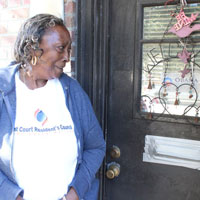
Climate Disruption and the Poor
View the page for this story
From sea level rise to hurricanes, climate change impacts are already having life-threatening and life-altering effects on people all around the globe, including in the U.S. Without the financial means to adapt or recover, disadvantaged groups are especially vulnerable to these impacts. Journalist Lewis Raven Wallace, in partnership with Environmental Health News and Scalawag Magazine, reported on how the devastation of a public housing complex in New Bern, North Carolina during Hurricane Florence has left many of its African American residents homeless. Wallace talks with Host Steve Curwood. (11:11)

Beyond the Headlines
/ Peter DykstraView the page for this story
This week, Peter Dykstra joins Host Steve Curwood on a trip beyond the headlines to take a look at the work of a high school student who discovered 50,000 golf balls in the sea and shore of Monterey Peninsula. They also talk about the Government Accountability Office’s recommendation that State Dept. diplomats should be briefed on climate change. Finally, they take a look back at the 1969 Santa Barbara oil spill and how it helped spark the public’s awareness of environmental issues. (04:20)
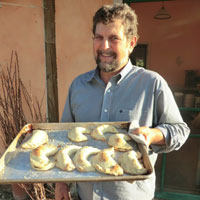
Healing Our Land and Communities Through the Power of Food
View the page for this story
As an agricultural biologist, ethnobiologist and author, Gary Paul Nabhan is a renowned pioneer in the local food movement. In his new book, Food from the Radical Center: Healing Our Land and Communities, Prof. Nabhan writes about the power of working the soil with our hands in a collaborative spirit, with disparate groups. Gary Nabhan and host Steve Curwood discuss how restoring the health of our lands can improve the health of our communities. (14:01)
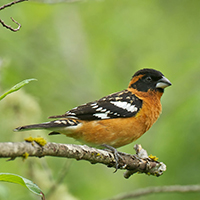
BirdNote®: Where Are They Now?
/ Michael SteinView the page for this story
During the Northern Hemisphere’s coldest days of the year, migratory birds that fly south for the winter warm their wings in the copious sunshine near the Equator. BirdNote’s Michael Stein tracks down these savvy sun-seekers. (02:15)
Show Credits and Funders
Show Transcript
HOSTS: Steve Curwood
GUESTS: Gary Paul Nabhan, John Sutter, Lewis Raven Wallace
REPORTERS: Mark Seth Lender, Peter Dykstra, Michael Stein.
[THEME]
CURWOOD: From Public Radio International – this is Living On Earth.
[THEME]
CURWOOD: I’m Steve Curwood.
Trying to hold back the tide of migration from Central America may well be going against the tide of climate disruption.
SUTTER: This is a time of walls, you know? We're putting up barriers here, elsewhere in the world, trying to slow the movement of people, when we know, in just this one way, that there's going to be this macro problem of climate change that is going to push people out of their homes, and I think that's something that we have to reckon with.
CURWOOD: Also, flooding linked to climate change is forcing people right here in the US to invest in raising up their homes, but what about the poor?
WALLACE: The reality is that developments for wealthier people, where they're spending more money on it, can be built up to sort of new code and raised up off the ground in a way that we're not seeing that sort of investment in low-income housing, and certainly not in public housing in this day and age.
CURWOOD: That and more this week on Living on Earth – Stick Around!
[NEWSBREAK MUSIC: Boards Of Canada “Zoetrope” from “In A Beautiful Place Out In The Country” (Warp Records 2000)]
[THEME]
CURWOOD: From PRI and the Jennifer and Ted Stanley Studios at the University of Massachusetts Boston, this is Living on Earth. I’m Steve Curwood.
Climate Migrant Caravans
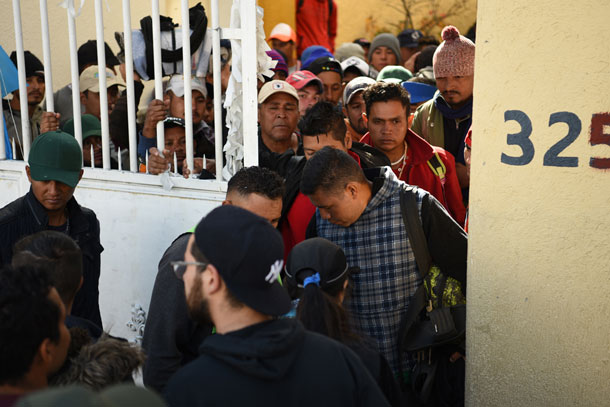
Many of the Central American migrants seeking asylum have been driven to desperation by the impact of climate change, extended drought and shifting growing seasons, which have led to crop failure. (Photo: Daniel Arauz, Flickr, CC BY 2.0)
Migrant caravans made headlines during the US Fall 2018 elections as groups several thousand strong from Central America trekked north towards the US, stoking xenophobic rhetoric and fears. Even now, the caravans continue, as people from Guatemala and Honduras seek sanctuary for a variety of reasons, including attempts to escape violence and poverty. And a less visible factor is climate disruption. John Sutter is a Senior Investigative Reporter for CNN who went to rural Honduras to report on climate change and immigration. He spoke with Living on Earth’s Bobby Bascomb.
BASCOMB: You went to Western Honduras near Copán for this story. First, tell me about some of the families that you spent time with there.
SUTTER: One woman I met her name was Delmi Amparo Hernandez. And she's living in a pretty small village on a mountaintop in Copán, just very near the Guatemalan border, actually. And her husband left in one of the caravans last year. Germán was his name. For the last five years, this region has just been hit with this intense drought. And you know, they’re subsistence farmers, completely reliant on maize crops. Their family was really struggling, and so when he heard about the caravan coming through, like, you know, many other people I met, he made almost a decision in that moment to go and join them. And so, you know, she was left behind with her children. And I found it just really heartbreaking that she, and some other people I met, really had almost no way of knowing what happened after that point. So he left without a phone, he left with a phone number in his pocket in case he found a way to call back, and to call a neighbor in this village and let her know how things were going. In a lot of the places I've visited, there's just this incredible, real sadness in that there are so many people and a lot of, like, working-age adults who are missing, and single parents left behind to try to fend for their families and fill in that void.
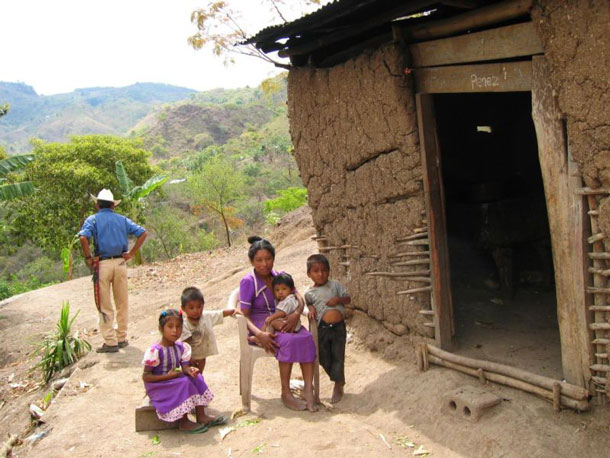
The spring rains in Central America are crucial to the growth of the corn crop, which itself is crucial to the Central American diet. For the last five years, the rains have either arrived in the wrong season, or sometimes not at all. (Photo: André Schütte, Wikimedia Commons, Public Domain)
BASCOMB: Now, tell me a bit about the drought that forced him to make that difficult decision. How long has it been going on? And in what ways is it impacting people there?
SUTTER: So this drought has lasted about five years. And in some places, it's hit harder than others. There's what's called the dry corridor of Central America, which, as that name suggests, it's normal, that the dry corridor would be dry. But some of the climate scientists I've talked to say that in the last number of years, they've started to see some things that seem unprecedented. In particular, spring rains, which are incredibly important for corn crops, which is, a staple in this region that they just haven't been coming. Like, they're almost completely missing when you look at the average rainfall by the month. So it's partly that rains have decreased, it's partly that they've shifted and are no longer falling in the seasons when they have been, you know, so useful the farmers in the past. But it's been very troubling and created a lot of hardship because it's important to realize that this lot of people in the dry corridor of Central America are subsistence farmers. They're living day to day. In other parts of the world, like the US and parts of Europe, there are crop insurance programs and other ways to tide you over in bad years of farming. There, that's, you know, not the case and often there's no irrigation system. So if it's not raining, you don't have a way to pump water in from a canal or from the groundwater to supplement your crops. They just don't grow. And so I think that's why there's been such an intense crisis there. I mean, the UN Food and Agriculture Organization says there are 2 million people in this region in the world who are at risk for hunger. It's not like they've never seen drought before, but this one has been particularly intense and troubling for farmers there.
BASCOMB: You write in your story that corn and bean crops are failing, and those are staple crops in the region. And, I know that corn is king there. I mean, people eat corn tortillas for breakfast, lunch, and dinner every day, literally. So I can imagine that if the corn crop is failing, as you mentioned, you're looking at massive malnutrition and even starvation. This is a really desperate situation.
SUTTER: Yeah, it really is. And I think that's another thing people underestimate about the caravan or any migration story, really, when you hear about it. It has to be really bad for you to want to flee a problem. There's an incredible attachment to a sense of home and place, especially among people who are farmers, and who are attached to the land. It's a big deal to think about leaving, and that gives you a hint at like, how intense the situation is, for many farmers. The experts on hunger, on starvation, people with the UN, for example, who I spoke with, they all say that this stuff is cumulative. If you have one bad year, and the rains don't fall, that creates a certain stress. If you have year, after year, after year, and at this point, essentially five years of very bad drought conditions, then that's where you start to create conditions that can lead to hunger, starvation, these truly serious problems.
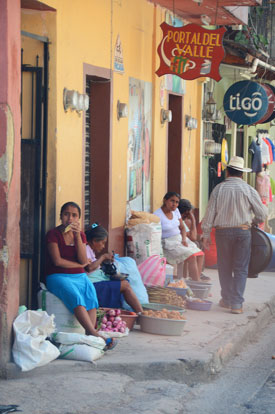
Copán, Honduras, was originally a thriving tourist destination, but drought-induced crop failure has led to an economic downturn and many climate refugees have fled their land. (Photo: Alex Keshavjee, Flickr, CC BY-NC 2.0)
BASCOMB: Now, you quote the Commissioner of the US Customs and Border Protection in your article. And he says that crop failure directly translates to who is arriving at our border. But President Trump has been widely saying that immigrants in our southern border would be terrorists and drug dealers and things like that. It sounds a bit like the left-hand doesn't know what the right hand is doing.
SUTTER: Yeah, I mean, I think that that's the case with several of the agencies, right? But I was surprised that, you know, that officials were saying this is part of what's happening, and if that they had that awareness, I thought that was encouraging actually. I wish that the administration, or really anyone in Washington, would talk about this issue of migration in terms of climate change, because the projections for how many climate migrants or climate refugees there will be in the world are uncertain. And we're not preparing for that. If anything, the United States and European countries are doing the opposite, right? Like, this is a time of walls. You know, we're putting up barriers here, elsewhere in the world, trying to slow the movement of people, when we know that in just this one way, that there's going to be this macro problem of climate change that is going to push people out of their homes. And I think that's something we have to reckon with.
BASCOMB: Here on the news, we're hearing that a lot of this migration is due to gang violence and murders, you know, violent crime that's forcing people to leave their homes. But you write that the data doesn't really show that. Can you tell me about that?
SUTTER: Yes, it certainly really doesn't show that for this region, the area of Western Honduras where we spend our time and that we went to basically, because of the data that we saw. The crime rate has been going down in recent years. And we got data from the US Border Patrol that showed the sort of place of origin of people who were apprehended at the US border, and there was just this big percent increase, this spike in people coming from Western Honduras. And so I think migration stories are always complex. But I think it's not untrue, that violence is driving people out. It's not untrue, that poverty is driving people out. But it is also true that climate change and severe drought are causing people to move from that region, and from others. And I think that we have to look at that in a clear-eyed way. And think about what that means. Because the United States…we've done more than any other country to cause warming. The planet has warmed about one degree Celsius already because of people burning fossil fuels and other activities. And we're responsible for a good chunk of that. And that warming is displacing people now and is projected to displace, you know, ever-larger numbers of people moving forward. And so I think it's this really important moral question we need to ask ourselves. We're causing this hardship in parts of the world, many of us may never travel through or never see, but that stuff is real. And it's causing repercussions, one of which is that people are on the move to try to make ends meet, to try to make a livelihood, and to try to keep their lives moving. And so I think for me, it doesn't invalidate the other stories that we've heard about the caravan, but it certainly complicates them. And there's another layer to that story that I think isn't being told.
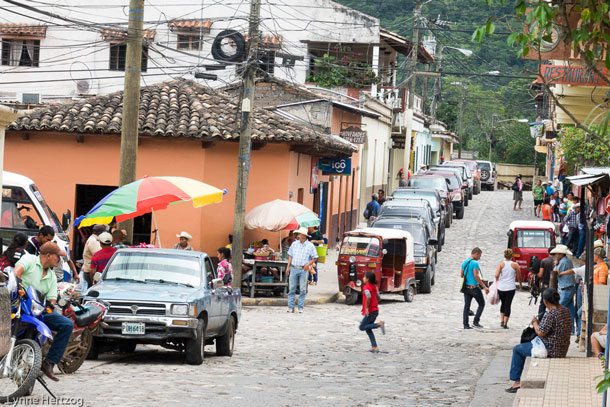
The story of Delmi Amparo Hernández and her family is an increasingly common one. In 2012, before the drought, only 3.7% of Honduran migrants came from the area surrounding Copán. These days, that percentage is over 9%. (Photo: Lynne Hertzog, Flickr, CC BY-NC 2.0)
BASCOMB: By the way, before you leave us, what happened to the family that you talked about at the beginning of our chat here? What happened with her husband, and how did their situation unfold?
SUTTER: Delmi, who is one of the people I met on this trip, her husband left in the caravan. She went next door to a neighbor's house, basically to check on a TV, to look on the TV news for coverage at the caravan to see if she could spot him. And instead, she and other people in Central America were seeing these images of, you know, people jumping off of bridges to try to make it across borders, being met with tear gas at the US border in Tijuana. But in Delmi’s case, she found out from like a stunning phone call that she got, that her husband died on the path north. And that happened in Guatemala. She doesn't know a whole lot of details around exactly what happened. She showed me, you know, what documentation she did have. But she's just stunned and in grief and trying to figure out how to take care of their children alone. The people in her community are helping her, the group World Vision actually has been delivering her food from time to time. To me, it speaks to the extremity of the conditions down there, and how desperate this man was to provide for his wife and his family. And he paid, you know, the ultimate price for that.
BASCOMB: Well, you mentioned that this one family is getting some help from their neighbors and some assistance from NGOs. But looking at the larger picture, I mean, what kind of help is there for struggling Central American farmers? I mean, are they getting aid from international organizations or their own government?
SUTTER: I think that's the one really hopeful part of this story, right, is that in a piecemeal fashion, there are, you know, NGOs and some governments that are trying to fund, like, projects in the dry corridor of Central America to make farming a little easier. I mean, the main thing, one of the main things that can happen is irrigation projects, right? If you have an irrigation system, and you can tap water, when it isn't falling from the sky, you're a lot more resilient to the effects of climate change. Climate change happens in the margins. It's not like droughts never happened before or hurricanes never happened before. But climate change makes these things worse. And that can push people over the edge into situations of starvation, or migration, or all these things we've been talking about. So I think anything the international community can do to invest in some of those projects is smart. And depending on who you talk to you, there are climate policy experts who think that the big industrialized countries of the world, the US, Europe, China, that we owe that to places that are dealing with the effects of climate change and that have done little if anything to cause it.

John D. Sutter is a Senior Investigative Reporter for CNN (Photo: Courtesy of CNN)
CURWOOD: John Sutter of CNN speaking with Living on Earth’s Bobby Bascomb.
Related links:
- CNN | “One Suspected Driver of the Migrant ‘Caravan’: Climate Change”
- Click here to hear our previous coverage of Central America’s Climate Refugees
- The Guardian, | “The Unseen Driver Behind the Migrant Caravan: Climate Change”
[MUSIC: Chancha Via Circuito, “Los Pastores” on Bienaventuranza, by William Centellas, Wonderwheel Recordings.]
Climate and the Majestic Gyrfalcon

The gyrfalcon is the largest falcon in the world. (Photo: Mark Seth Lender)
CURWOOD: Climate disruption is not only forcing people to move, it’s also changing the ranges of animals. This can lead to conflict as Our Explorer in Residence, Mark Seth Lender, found at Churchill Point in Northern Canada. There he saw two species of falcons that usually live in separate habitats meet on the frozen tundra.

Gryfalcon usually remain in the far north all year. (Photo: Mark Seth Lender)
LENDER: The Arctic wind comes blade flat, fleshing the thin and the fat from the bone of the land. Freezing, the breathe in your mouth the tears in your eyes your lips, turned to match the no-color perceived of every direction. Out of which blows Gyrfalcon! He closes his wings, and holds, the grains swirling, his feathers curling, hunkered, his head tucked into his shoulders with only himself for shelter.
And lifts. And like a ghost, gone. Into the fierceness…
Moments later he fights his way back, to the same roost. And the blizzard stops just the way it started, a shallow excuse for clearing: Thirty knots ten below. A weather Gyrfalcon does not bend to. As if it were nothing. Nothing at all. Knowing, there will be worse to contend with.
Gyrfalcon ruffles, and arranges, and tucks, in his plumage in the miserly light. He cocks his head and leans far to the side. And straightens. And looks the other way. And all the way round behind him.
Searching, for what? For something to kill? What for? There is blood on his feathers already. Fresh blood. He ate. He feasted. Now should spend his time cleaning himself. But does not do so except for his feet brought up with easy balance to his beak. Then only stands there.

When on the hunt, gyrfalcon often swoop low to the ground to sneak up on prey. (Photo: Mark Seth Lender)
Recognition dawns slowly. He is not blooded. The blood is, his own.
Puncture marks laid down in groups. In twos. In threes. And the deep wounds on his back. So many. They tell a story. That he was hit from behind, low, there above his tail and that the blow drove him down. And he rolled. And laid on his back. The defensive tears on the skin of his feet tell you that, and the blood on his breast and belly also. And on his face. Meaning, the falcon went for his eyes. A peregrine, that’s all, the only one it could be. Smaller, lighter by half but fast, and his talons honed, and his eye unswerving.
Peregrine cannot be blamed for who and what he is. But this was not the work of Nature.
We did this. We have dragged the Southard North and crushed the North against itself. The peregrine should not have been here. Not when Gyrfalcon came down.
This is our result. Gyrfalcon will survive the night. But not the winter.
CURWOOD: That’s Living on Earth’s Explorer in Residence, Mark Seth Lender. For photos, check out our website, LOE.org.
Related links:
- For information on visiting Churchill Point contact Frontiers North Adventures
- To learn more about the wildlife of Churchill Point visit Polar Bears International
- Mark Seth Lender’s Website
[MUSIC: Chancha Via Circuito, “Baru” on Bienaventuranza, by William Centellas, Wonderwheel Recordings.]
CURWOOD: Coming up – internal displacement from climate change right here in the US. Stay tuned!
ANNOUNCER: Support for Living on Earth comes from Sailors for the Sea and Oceana. Helping boaters race clean, sail green and protect the seas they love. More information at SailorsfortheSea.org.
[CUTAWAY MUSIC: Chancha Via Circuito, “Los Pastores” on Bienaventuranza, by William Centellas, Wonderwheel Recordings.]
Climate Disruption and the Poor
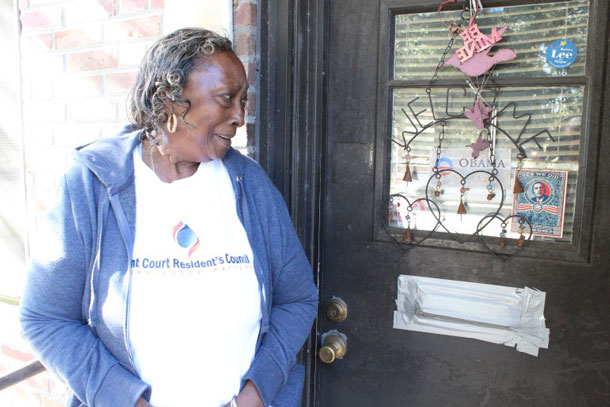
New Bern resident Cheryl Reed outside her empty townhouse at Trent Court. (Photo: Lewis Raven Wallace)
CURWOOD: It’s Living on Earth, I’m Steve Curwood.
When Hurricane Florence blasted ashore September 14th in North Carolina, it touched off two weeks of severe flooding in the region, and probably no town was hit harder than New Bern along the Neuse River. Trent Court is an aging public housing complex in New Bern. The floods made it unlivable and the bulk of its residents are now struggling through the winter with no safe and secure place to call home. Lewis Raven Wallace reported this story for Environmental Health News and Scalawag Magazine.
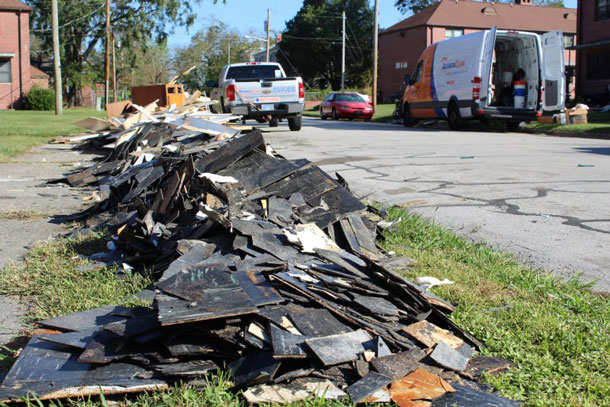
Rubble outside of apartments at Trent Court Housing Development, a public housing project near the waterfront in eastern North Carolina. Half the units at Trent Court were flooded during Hurricane Florence. (Photo: Lewis Raven Wallace)
WALLACE: I’m in New Bern, North Carolina, just getting to a church a few blocks from Trent Court housing projects—some guys here are unloading blocks of cement from a truck…right into the doorway
Putting the steps back in right now. I’m here to meet Cheryl Reed, who’s the head of the Trent Court resident council…
REED: So here we are. Would you like to see the stuff we got?
WALLACE: Yeah, please.
REED: It's donated to us to give to our residents…
WALLACE: Cheryl’s all set up in the church basement giving away food staples, diapers, bleach, and hand sanitizer for cleaning. She’s also one of the people, though, who’s permanently displaced by Hurricane Florence…her townhouse in Trent Court public housing was totally flooded.
REED: During the hurricane, it came up four and a half feet.
WALLACE: So you were upstairs?
REED: Yeah. It was scary...wasn't so scary until we heard the crash, and that was the refrigerator. The water lifted it up and turned it over. I finally had to evacuate my apartment.
WALLACE: She tried hard to stay home, because she didn’t want to separate from her dog…
REED: He’s a Cairn Terrier, he's called Winston Churchill. We're two old farts together.
LEWIS: The shelters couldn’t take dogs…but the water kept rising
REED: But eventually I had three outstanding people come and insist that I leave…
WALLACE: She ended up in a shelter for 11 days, and she was anxious the whole time…
REED: And long story short, I got my dog back.
WALLACE: Oh good. I was starting to worry...
REED: I did for a couple of days, and I was bombarding the lady that runs it with constantly calling, calling. And finally she called me and she said, don't worry, sweetie, he's fine.
WALLACE: He was with a foster family—now he’s back with her, in senior housing she’s been able to move into. We head over to Trent Court. It’s a squat collection of brick townhouses, right next to the waterfront.
REED: This is set for demolition. That's the main office over there. And you see how close we are to the water? Yeah, the river was over here.
WALLACE: It’s quiet here and the curbs are still covered with people’s trash, and the gutted insides of houses. Cheryl brought along another member of the resident council.
WALLACE: Can you say your name and where we are?
BUCK: My name is Tyechia Buck and we are in Trent Court
WALLACE: Headed into your apartment. How long have you lived here?
BUCK: I have lived here…November the 12th will be 12 years.
WALLACE: What was your feeling when you came back?
BUCK: I turned my key [opening door sounds] and opened my door and busted out crying.
WALLACE: Was there still water in here when you got back?
BUCK: Yeah. It was about four and a half feet in my apartment. This is where my kitchen sink was. My washer hookup was here, I had a counter over here.
WALLACE: Tyechia and her twelve-year-old son stayed with family, and then a hotel. But their apartment is now on the demolition list…she’s lived in Trent Court more or less her whole life.
Have you ever been through anything like this before?
BUCK: No, this was the worst storm I've ever endured in my twelve years. This is the worst one I remember, period. I'm 36 years old, and been out here for twelve. I grew up here. My mom moved out. You know, we got a house and moved out. My dad died couldn't afford to pay the mortgage anymore so I came back here. And I've been here ever since.
WALLACE: Half the buildings at Trent Court have been approved for demolition by the Department of Housing and Urban Development, with no replacement coming soon. That’s more than 100 families like Tyechia’s with nowhere to go. Now she’s staying in her own empty apartment—no heat, no hot water—so her son can stay in school here in New Bern. She’s considered a squatter.
BUCK: You know, it’s kind of devastating a little bit. I’ve never been through something like this before.
WALLACE: Long term, she’s not sure where she’ll end up.
CURWOOD: That’s Lewis Raven Wallace, who reported from New Bern for Environmental Health News and Scalawag Magazine and he joins us now on the line.
Welcome to Living on Earth, Lewis.
WALLACE: Thanks for having me.
CURWOOD: Talk to me about the history of this community, this African American community and its culture.
WALLACE: So New Bern itself is an old city, it's about 308 years old. And it was an early sentiment place for free black people before emancipation. So, there's a truly historic African-American community there of folks who are seventh generation, 10th generation, New Bernians. Right after emancipation, during Reconstruction, the area that Newbern was in elected, you know, some of the largest percentage of black representatives to Congress of anywhere in the South. And so, it's been a really politically active and culturally meaningful center in eastern North Carolina for the black community there. The historic black neighborhoods were also among the areas that were really hard hit by Hurricane Florence, in addition to the public housing.
CURWOOD: Now, what was the plan for this public housing before and after the storm?
WALLACE: So Trent Court public housing was a lot of this kind of 80 to 100 year old public housing around the country, in that it hadn't been properly up kept for a pretty long time. And for several years now, the local housing authority had been developing a plan to demolish Trent Court and move everyone out of there. In general, when the Department of Housing and Urban Development does that, there is a fairly extensive planning process around making sure that, at least in theory, there's a one-to-one replacement of those units, and folks get vouchers, and they can go someplace else. The way it plays out in practical terms, and has played out has been that about half the folks who leave public housing that gets demolished, don't end up in another public housing unit for a whole variety of reasons. One of the reasons is this sort of situation that we see here in New Bern, where the demolition, due to the housing being in a floodplain, it is now going to happen before schedule and way before there's a replacement housing for folks.

Inside of New Bern resident Tyechia Buck’s apartment at Trent Court Housing Development, everything was gutted after the flooding of Hurricane Florence. She now lives there without electricity. (Photo: Lewis Raven Wallace)
CURWOOD: So people worry about climate gentrification. How could it happen in this place? New Bern, North Carolina.
WALLACE: Well, so it follows a pattern that we kind of most famously saw in New Orleans after Katrina, it just so happened that a lot of that public housing was situated on pieces of land that would ultimately become very, very valuable for redevelopment of new housing for wealthier people. And the same is true at Trent Court in New Bern and a lot of public housing units. 80 years ago, some kind of low lying brick homes down by the river were maybe not considered prime real estate. Now that New Bern’s sort of main economy is tourism, and there's talk about redeveloping the river front and creating a river walk, the Trent Court housing development again, like a lot of that public housing in New Orleans is located in a place that, you know, could become very, very valuable land for real estate developers. Everybody knows that, and everybody sees that, there are real estate developers who sit, you know, on the city council of New Bern. But the reality is that developments for wealthier people where they're spending more money on it can be built up to, sort of, new code and raised up off the ground in a way that we're not seeing that sort of investment in low-income housing, and certainly not in public housing in this day and age. So it sort of happens along this pattern that maybe seems inevitable, but also could be interrupted by public policy or political interventions. And there are certainly people in New Bern who are pushing for that.
CURWOOD: So, convenient then, that the storm came along and accelerated the demise of this public housing from the perspective of some. To what extent is that true?
WALLACE: I think that everybody that I interviewed in New Bern believes that nobody should be displaced, with no place to go. That said that's already happened there's more than 200 people who lost their homes at Trent Court. The reality in New Bern is that there's not a lot of rentals available, that pushes up the price of rentals. Landlords don't have to even take Section 8 vouchers in North Carolina. That's completely up to them, it's legal to discriminate against Section 8 renters. As to whether there are people sort of clapping their hands and cheering about that, nobody's doing that openly, right? But there's also a visible lack of political will, and I would say, particularly at the federal level, to stop this kind of thing from happening.
CURWOOD: Now, what about other poor people being disrupted by climate change and becoming refugees? There is, of course, as you mentioned, the classic case of Katrina, but, how big is this in North America?
WALLACE: Well, something that I find kind of stunning with regard to the public housing situation is that we don't exactly know, you know? After Harvey, obviously, after Katrina, Florence, Matthew, there were a bunch of people in the Florida Panhandle who were displaced, just this last fall,from public housing. But it's not evident to me that that's being sort of clearly tracked. We conduct a census, but we don't track individuals from one place to another demographically across the United States as they move.
CURWOOD: So what would you say the numbers are?
WALLACE: So, one study from the University of Georgia predicts right now that sea level rise alone, so that's just accounting for the effects of sea level rise, and not other climate change effects like drought, or, you know, food shortages that are related to the weather. Sea level rise alone could displace as many as 13 million Americans by the end of this century. Another study found that 1.68 million Americans were internally displaced by disasters just in 2017. So, that's not even including the folks that I've written about here who were displaced in 2018.
CURWOOD: Lewis Raven Wallace is a journalist and editor based in Durham, North Carolina. Thanks so much for taking the time with me today.
WALLACE: Thank you for having me.
Related links:
- Scalawag Magazine | “Poor southerners are joining the globes climate migrants”
- Environmental Health News | “Lingering long after a storm, mold and mental health issues”
- Video footage from the Associated Press on the destruction in New Bern, North Carolina after Hurricane Florence
- For more stories by Lewis Raven Wallace
[MUSIC: Chris Thomas King, “Hard Time Killing Floor Blues” on O Brother Where Art Thou (Soundtrack), by Nehemiah “Skip” James, Lost Highway Recording.]
Beyond the Headlines
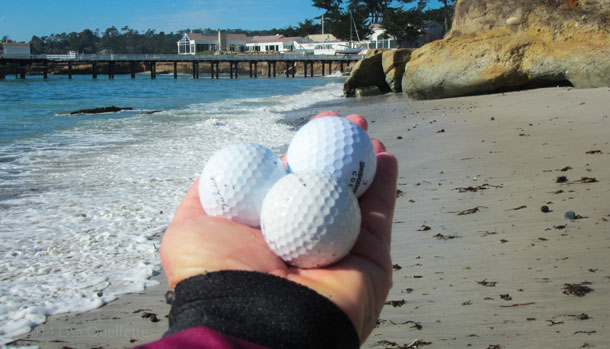
50,000 golf balls have been found in and around the Monterey Bay, but the courses estimate that over 100,000 golf balls may be lost each year. (Photo: Lisa Ouellette, Flickr, CC BY-NC-ND 2.0)
CURWOOD: Let’s take a look beyond the headlines now with Peter Dykstra. Peter’s an editor with Environmental Health News. That's EHN.org and DailyClimate.org. He’s on the line now from Atlanta, Georgia. Hey there, Peter, what’s going on?
DYKSTRA: Hi, Steve. I want to talk about a high school science project for the ages. This is a high school junior at Carmel High School in California. With some friends she began diving and snorkeling off the Monterey Peninsula, one of the most beautiful coastal sites in the country. It's also a site of some of the most prestigious golf courses in the US. And near those golf courses, she and her friends found 50,000 golf balls along the beach, and in the shallow water offshore. The most important part of that is what's in the golf balls. They have a plastic coating that degrades into microplastics that are recognized as a serious threat to the world's water, corals, and other marine life.
CURWOOD: So, Carmel, California, that's the home of Pebble Beach. That's a famous golf course.
DYKSTRA: Yeah, Pebble Beach is the most famous of the several courses out there. Alex Weber is the name of the high school student. She got a Stanford grad student involved. Together they got their work published in a peer-reviewed journal called the Marine Pollution Bulletin. Those golf courses and their superintendents threw in an estimate that there might be twice as many other golf balls, 100,000 golf balls, just offshore.
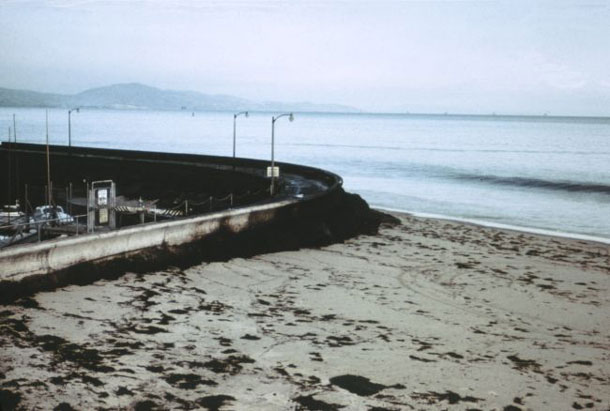
During the 1969 Santa Barbara oil spill, approximately 3 million gallons washed up on shore. (Photo: United States Geological Survey, Wikimedia Commons, Public Domain)
CURWOOD: Who knew that golf was a hazard to our oceans?
DYKSTRA: It is, and maybe we should have EPA charge a two-stroke penalty for each one of those 50,000 golf balls.
CURWOOD: Hey, what else do you have for us this week?
DYKSTRA: Migration, and particularly immigration, are much in the news lately, of course. And last week, the Government Accounting Office issued a recommendation that the US brief its diplomats on climate change, something this country stopped doing a couple of years ago.
CURWOOD: Okay, climate change is of concern to, I think, all of us. Why do diplomats need a special briefing?
DYKSTRA: A big part of it is the concept of climate refugees. It's a term we hear more and more, in low lying places like Bangladesh, and even in affluent, low lying places like South Florida. People who have moved, or may soon have to move because of rising seas, more intense storms and the other impacts of climate change.
CURWOOD: Well, wait a second though, Peter. I mean, the Department of Defense, the Central Intelligence Agency, a bunch of federal organizations say that climate change can contribute to insecurity, instability for entire nations. So, what's with the State Department?
DYKSTRA: Maybe they didn't get the memo. Even though the State Department has also in the past written some memos about the risks of climate change, and particularly, that sea level rise and other impacts can cause instability to entire nations, or entire regions of the world. They should be regarded as both an international and a national security threat.
CURWOOD: Hey, what do you have from the history vaults for us?
DYKSTRA: Really big 50th anniversary, January 28, 1969. There was a coastal catastrophe off the beautiful city of Santa Barbara, California. A blow out on a union oil rig just off shore. The estimates range up to 3 million gallons, not just spilled, but washing up on the beautiful beaches of Santa Barbara, and some more pristine areas both to the north and south of the city. 3 million gallons, the Gulf Oil Spill back in 2010 was 60 times as big. But because that Santa Barbara spill was near shore, and on camera, with an oily mess on wildlife and beaches, it got a huge amount of attention. That accident, along with, within the year, the Cuyahoga River catching fire and burning in Cleveland, are two things credited with inspiring the modern environmental movement.
CURWOOD: And who was Governor of California and who was President at those times?
DYKSTRA: Ronald Reagan was governor, and Richard Nixon of California was President.
CURWOOD: Ah, so the next year when the EPA gets started, maybe he's thinking of this, huh?
DYKSTRA: That’s right.
CURWOOD: Thanks Peter for taking the time with us today, we'll talk to you again real soon.
DYKSTRA: All right, Steve, thanks a lot. Talk to you soon.
CURWOOD: And there’s more on these stories at our website, LOE.org.
Related links:
- The Conversation | “A Teen Scientist Helped Me Discover Tons of Golf Balls Polluting the Ocean”
- Inside Climate News | “Climate Change Is Key Part of Understanding Migration, GAO Tells Trump Administration”
- Los Angeles Times | “The 1969 Santa Barbara Oil Spill That Changed Oil and Gas Exploration Forever”
[MUSIC: Eric Clapton, “My Father’s Eyes” on Pilgrim, by Eric Clapton, Reprise Records.]
CURWOOD: Living on Earth is available to you as a resource any time you need it on the internet at loe.org. There you can hear and read our stories going back nearly three decades, as well as listen to the current show. And you can also find links to our sources and references. But it’s now time to update our website and we’d like to find out what changes you think we should make to our online presence. So please volunteer your advice, comments and suggestions about our web site to comments@loe.org. That’s comments@loe.org, Or call 617-287-4121, 617-287-4121.
Just ahead, healing the land and society one garden at a time. Keep listening to Living on Earth.
ANNOUNCER: Funding for Living on Earth comes from you, our listeners, and United Technologies, combining passion for science with engineering to create solutions designed for sustainability in aerospace, building industries, and food refrigeration. UTC companies such as Otis, Carrier, Pratt and Whitney, and UTC Aerospace systems are helping to move the world forward. You can learn more about United Technologies by tuning into the Race to Nine Billion podcast; listen at racetoninebillion.com. This is PRI, Public Radio International.
[CUTAWAY MUSIC: Ikebe Shakedown, “She’s Knocking” on The Way Home, by Mike Buckley/Vince Chiarito, Colemine Records.]
Healing Our Land and Communities Through the Power of Food
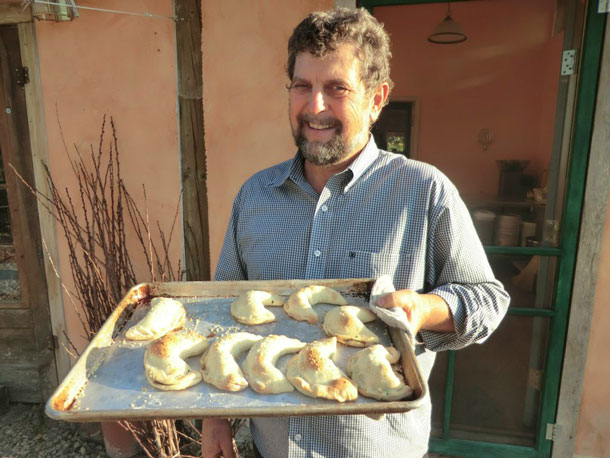
Gary Paul Nabhan is not only an author. He is also an agricultural ecologist, ethnobiologist, and the Kellogg Endowed Chair in Southwestern Borderlands Food and Water Security at the University of Arizona, and a local food movement pioneer. (Photo: Gary Paul Nabhan)
CURWOOD: It’s Living on Earth, I’m Steve Curwood.
Gary Paul Nabhan is a pioneer in today’s local food movement. He is an agricultural ecologist at the University of Arizona and author of the new book Food from the Radical Center: Healing Our Land and Communities. Gary says digging our hands in the soil while collaborating across the current political divide can provide some of the best solutions to restoring not only the health of our lands, but also the health of our communities. Thank you for being with us today, Gary.
NABHAN: Oh, it's great to see you, Steve. Thank you.
CURWOOD: So, tell me what inspired the title of your book, “Food from the Radical Center: Healing Our Land and Communities”?
NABHAN: Well, I live in one of those rural communities, like many in America, where people are divided in terms of their political persuasions, almost 50/50 ethnic Hispanic and Anglo backgrounds. There's also Native American and African American folks in our community. And people of different faiths, and we've all gotten along together, but the political divide has concerned most of us, and with these last elections it seemed like our country was divided 50/50.
We can't let the politicians solve that problem for us. We need to do it, and what I found over the last four years is that the way we bring people back together who have had adversarial relationships or felt that they were in conflict with one another is getting themselves out together on the land and doing work to heal the natural world, and by doing so, we begin to heal our social and ideological differences as well.
CURWOOD: Gary, in your opinion, how does food heal these deep divides?
NABHAN: Well, first of all, we know that nearly every faith has that tradition of bringing people together at the common table, not just to eat together, but to listen to one another. When those communities get together on the land, as I've done with Southern preachers and Northern ecological restorationists - and we go out and build terraces, and slow down erosion, and a plant number of native plants to hold the soil in place so that we can grow food on that land as well. We are getting beyond our ideologies and we're seeing the talents, and observations, and skills, and even values of the people that we come together with in a way we couldn't if we were just inside.
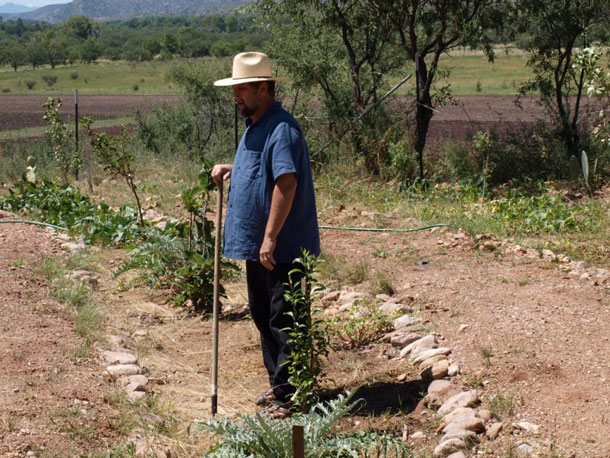
Gary Paul Nabhan believes that when people come together to work on the land that they have the power to come together as a community, as well. (Photo: Gary Paul Nabhan)
CURWOOD: At one point you write in your book, “We cannot vanquish poverty by bread alone”. What do you mean?
NABHAN: I think a lot of times our concern with helping the poor overcome food security means that we focus exclusively on food banks, and soup kitchens, and not about the root causes of poverty. We have to remember that it's not just space to grow plants for food that keep the poor from producing more of their food. It's access to seed fertilizer, planting materials that are within an affordable range. And so that's why there's no single solution to the poverty that brings on food security, you really need an integrated approach. It's not that people simply lack space. They may also lack time or access to seeds. And in Tucson where I've worked and lived for years, we now have 19 pre-seed libraries that distribute over 2,000 different kinds of seeds of edible plants to low-income residents just by going through the library and getting seed packets out of a library catalog box. And the interesting thing is 40 percent of those loans from the library are brought back with seeds back in the packets of people who want to share them with your neighbors. So, this is American democracy at work. Instead of paying now as much as $3 or $4 for 19 to 20 squash seeds in a packet at a health food store, people can get those same seeds for free through our libraries.
CURWOOD: So, how would you re-envision the public garden?
NABHAN: I would have it a multi-strata garden with edible fruit trees and native trees with edible berries and nuts above the vegetable and herb plantings that people could utilize as well, and we need that to deal with the urban heat island effects and reduce the impact of climate change on poor urban neighborhoods that, over years, have lost many of their trees rather than having places where those trees can flourish. We also need to build into government and low-income housing space for gardens and community kitchens and orchards, rather than seeing those as amenities only for the wealthy, or externalities that couldn't be worked into the budget of a housing project.
CURWOOD: Indeed, if you're low income, and maybe it's because you don't have a job or the greatest job, you've got a great incentive to go out there and grow your own food. It's tax-free, among other things.
NABHAN: And I think the greatest innovations in this country right now are that nexus between food justice, social justice, and environmental justice where grassroots alliances in our neighborhoods and barrios are bringing back their food producing capacity, and showing the rest of us how well it can be done in cities with community input.
CURWOOD: So, how do you feel about city planning with nature in mind?
NABHAN: I think it's essential. It's our kids who get out of school and have two or three hours of daylight after school to really explore the world in a positive way that we need to get out in city parks, and on bike trails and green belts and now many groups are making those edible forests along those bike trails, and green belts. And bus routes are being changed so that people can have access to those urban forests, and orchards, and urban planning, so fruit trees they're accessible to the indigent and homeless. It's not an either/or situation anymore that these should just be membership-only community garden. They should be accessible in all our public spaces
CURWOOD: Your book plays out to be something of a reminder as to how beautiful nature is and was, and at the beginning of your chapters, you asked these memory-invoking questions that link to critical points that you're making. So, why do you ask readers these questions, and what responses are you hoping to facilitate?
NABHAN: Well, I wanted to make sure that readers knew that this effort is not about me, or about a few seed savers or tree planters that are lone heroes. It's something that all of us have the capacity to do, that all of us who participated in stream restoration, or sewing of native grasses, or tree plantings enjoy and that everyone deserves credit. The community is the hero, not individuals who have made their names for being conservation superstars. The community is the appropriate base for long-term landscape restoration because this has to go on for more than one generation. True restoration of food producing landscapes has to start with the community rather than having community members as an afterthought.
CURWOOD: One of your chapters, you begin: “Have you ever been hiking and stopped in your tracks to gaze at wild flowers so vibrant and abundant that you couldn't keep your eyes off of them?”
NABHAN: You know, I was talking about Camas lilies that day in the Pacific Northwest. And I thought I was just going out to learn a lot of technical knowledge about how to do restoration with fire and removing exotic species. And then these women that have formed a multicultural team to do Camas restoration brought me into 400-acre meadow just filled with thousands of Camas lilies blooming. And I remember that anything that we do should really bring back the beauty of the world, not just the nutritional value of the world or the biodiversity value of the world, that we're inspired by that beauty, and it reminds us of the good work that many people have done in the days and years before us. So, beauty can't be left out of this equation.
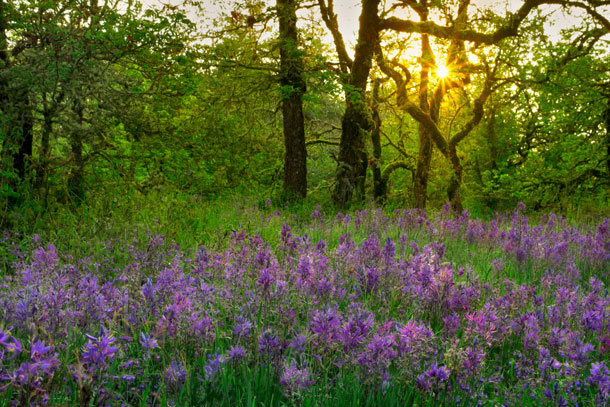
Camas Lilies are native to the United States and Canada. (Photo: Jim Choate, Flickr, CC BY-NC-ND 2.0)
CURWOOD: Yeah, sometimes we're so organized. I think of the Bluegrass Region in Kentucky. It's called bluegrass, but you never see the grass blue because it's only blue when it's blooming, when it's been allowed to kind of bolt and be free.
NABHAN: Yeah, sometimes we literally nip beauty in the bud.
CURWOOD: In your book, you talk about the shock that your grandfather endured as a fruit peddler. He was an immigrant from Syria. Talk to me about how you feel about the collective environment that surrounds the food in our nature. You know, how inclusive or supportive is it to immigrants and refugees, or for that matter, to diversity as a whole?
NABHAN: Well, Steve, I've just spent a month on the Lebanon-Syria border in Syrian refugee camps, just a few miles from where my paternal grandfather emigrated from a century ago. And I saw the incredible heartbreak and suffering of a half-million Syrian refugee farm workers, mostly women there. And it, of course, gave me incredible empathy with them, empathy with what my grandfather and millions of Syrian refugees went through exactly a century ago.
And I think we forget that our whole farming traditions and dietary traditions have been so enriched by what immigrants felt they had to carry with them. Seeds hemmed into their jackets and into their pockets so that they could carry what they loved in their former home into the United States to try to rebuild it. And it also reminds us that when many immigrants come to North America, they see its biodiversity and soil fertility, and access to water. Unbelievable compared to some of the conditions that they came from, and they want to help take better care of it. And my grandfather was one of those. He had to abandon his family orchard as he left the Ottoman War in in Syria, but as soon as he could start planting trees and selling fruit again, it was inimicable to his own identity, so central to him, and he literally taught all his grandchildren how to taste fruit in a way we just don't get to learn anymore just picking it up at a Quik Mart. Remembering that food is one of the last things that we leave as part of our cultural identities. We may lose our grandparents’ languages, or their way of doing business, but the food traditions carry with us much longer.
CURWOOD: Indeed. And what do you know about identifying the right fruit to eat or buy?
NABHAN: Well, I remember my grandfather having me smell a melon, cantaloupe, and feel the ridges on it to know when it was ripe. He said, the ridging, the veining, the netting on a cantaloupe will pop up and tell you when it's ready to be eaten, and then you smell its belly button, and that tells you how sweet it is, and whether it's ready to eat. And he did similar little exercises with me with figs, and pomegranates, and other fruits that he knew in the old world.
One of the things that my grandfather reminded me of was that, if we choose to find out when food is at its ripest, even though it may look bruised, and use it for its value at that time, we reduce food waste, and food waste is now 40 to 50 percent of everything harvested in American fields. And half of that happens after the grocery store, at the household level. So, knowing when our food is ripe and when it's ready to spoil and paying attention to it as it fully ripens, so that we can use it at the exact time is really helping reduce greenhouse gas emissions and the loss of perfectly edible food in a world where a large portion of the population is still food insecure.
CURWOOD: Oh my, Gary, you have me thinking of the summer, and here it is in the winter, and it was 20 something this morning where I am in the northern part of the US. You had me thinking of a peach so ripe that it's running down my hand, my arm as I try to get it up to my mouth, almost overripe, almost ready for the dustbin, but oh my, so delicious.
NABHAN: You know, and I think that's a key point that the sensuality of eating good food and the sensuality of working on the land, gardening is one of the most sensory rich pleasures that I engage in, are delights beyond words that apricots bite the drips down your chin as a burst forth with flavor and juices is a great pleasure to many people from the first time they eat an apricot. And food is not just about calories or cures. It's really about our deepest connections to the earth that we live on.

Food from the Radical Center: Healing Our Land and Communities was published in September 2018. (Photo: Gary Paul Nabhan)
CURWOOD: One of Gary Paul Nabhan's books for 2018 is “Food from the Radical Center: Healing Our Land and Communities”. Thanks for taking the time with us today, Gary.
NABHAN: Thanks again, Steve.
Related links:
- Learn more about Gary Paul Nabhan, his current projects, and other written works
- Where to order Food from the Radical Center: Healing Our Land and Communities
- Find out more about camas lilies
[BIRDNOTE THEME]
BirdNote®: Where Are They Now?
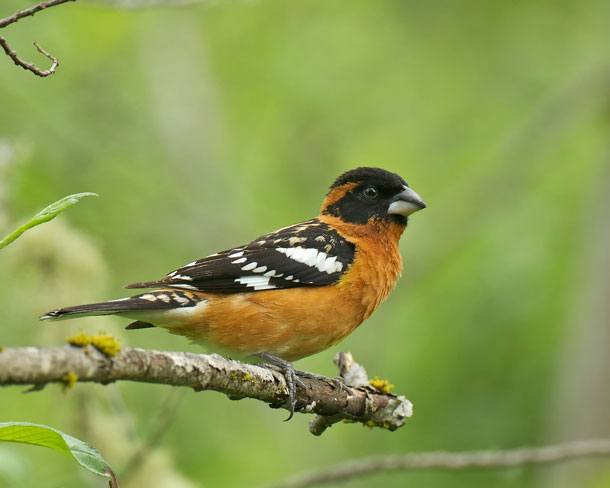
Black-headed grosbeak (Photo: © Gregg Thompson)
CURWOOD: Migratory birds that fly south for the winter are now warming their wings in the ample sunshine near the Equator. It’s hard not to envy them during the Northern Hemisphere’s coldest days of the year. So let’s live vicariously for a moment, and take a trip to Central and South America with BirdNote’s Michael Stein, as he follows these savvy sun-seekers.
STEIN: Where have the birds of summer gone? In July, you might have heard this dawn song – many birds singing at first light. [Full dawn chorus] Today, in winter, how utterly different the morning sounds.
[A few calls of Black-capped Chickadee.]
Where are the summer singers now?
[Song of the Swainson’s Thrush]
There’s the flutelike song of a Swainson’s Thrush, a bird now wintering in Central and South America, maybe as far south as Bolivia.
[Song of the Swainson’s Thrush]
Catch the rhythmic notes of a Warbling Vireo [song of Warbling Vireo] interspersed with lilting phrases of a Black-headed Grosbeak [song of Black-headed Grosbeak]
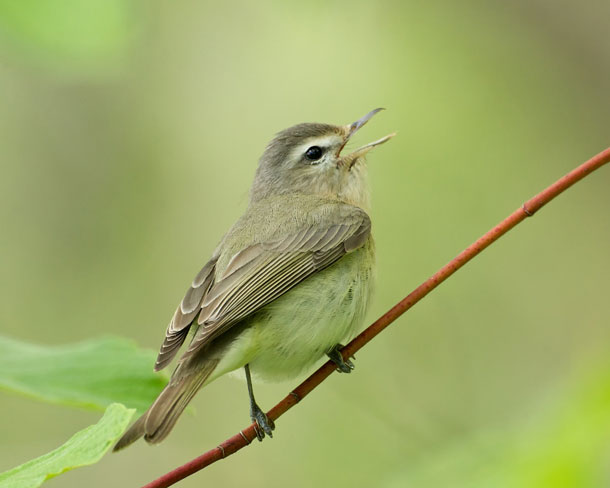
Warbling Vireo (Photo: © Gregg Thompson)
Warbling Vireos are now spread through much of Central America while Black-headed Grosbeaks have migrated to Mexico.
[Orange-crowned Warbler]
There’s the descending trill of an Orange-crowned Warbler, against a backdrop of robins. The warbler makes Mexico its winter home, as do some of the robins.
Now the raspy “fitz-bew” song of a Willow Flycatcher.
[song of Willow Flycatcher]
January finds it tucked away in Costa Rica or Panama. As winter turns to spring, these memorable singers will begin to fly north, where they will once again grace us with their rich dawn chorus.
I’m Michael Stein.
Written by Bob Sundstrom and Chris Peterson
Dawn Song and all birds except the featured Warbling Vireo and Black-headed Grosbeak were recorded by C. Peterson. Song of the Warbling Vireo and song of Black-headed Grosbeak provided by The Macaulay Library of Natural Sounds at the Cornell Lab of Ornithology, Ithaca, New York. Recorded by T.G. Sander.
Producer: John Kessler
Executive Producer: Chris Peterson
© 2005-2019 Tune In to Nature.org January 2019 Narrator: Michael Stein
CURWOOD: For pictures and more, migrate on over to our website, LOE.org.
[MUSIC: Wendy Rolfe/Maria Jose Carrasqueira, “Atrahente” on Images of Brazil, by Chquinha Gonzaga, Odyssey Discs.]
CURWOOD: Living on Earth is produced by the World Media Foundation.
Our crew includes Naomi Arenberg, Bobby Bascomb, Delilah Bethel, Thurston Briscoe, Jenni Doering, Don Lyman, Lizz Malloy, Aynsley O’Neill, Jake Rego, Adelaide Chen, and Jolanda Omari. Special thanks this week to Frontiers North Adventures.
Tom Tiger engineered our show. Alison Lirish Dean composed our themes. You can hear us anytime at LOE.org, iTunes and Google Play- and like us, please, on our Facebook page - PRI’s Living on Earth. We tweet from @livingonearth. And find us on Instagram at livingonearthradio. I’m Steve Curwood. Thanks for listening!
ANNOUNCER: Funding for Living on Earth comes from you, our listeners, and from the University of Massachusetts, Boston, in association with its School for the Environment, developing the next generation of environmental leaders. And from the Grantham Foundation for the protection of the environment, supporting strategic communications and collaboration in solving the world’s most pressing environmental problems. Support also comes from the Energy Foundation, serving the public interest by helping to build a strong, clean, energy economy and from Carl and Judy Ferenbach of Boston, Massachusetts.
ANNOUNCER 2: PRI, Public Radio International.
Living on Earth wants to hear from you!
Living on Earth
62 Calef Highway, Suite 212
Lee, NH 03861
Telephone: 617-287-4121
E-mail: comments@loe.org
Newsletter [Click here]
Donate to Living on Earth!
Living on Earth is an independent media program and relies entirely on contributions from listeners and institutions supporting public service. Please donate now to preserve an independent environmental voice.
NewsletterLiving on Earth offers a weekly delivery of the show's rundown to your mailbox. Sign up for our newsletter today!
 Sailors For The Sea: Be the change you want to sea.
Sailors For The Sea: Be the change you want to sea.
 The Grantham Foundation for the Protection of the Environment: Committed to protecting and improving the health of the global environment.
The Grantham Foundation for the Protection of the Environment: Committed to protecting and improving the health of the global environment.
 Contribute to Living on Earth and receive, as our gift to you, an archival print of one of Mark Seth Lender's extraordinary wildlife photographs. Follow the link to see Mark's current collection of photographs.
Contribute to Living on Earth and receive, as our gift to you, an archival print of one of Mark Seth Lender's extraordinary wildlife photographs. Follow the link to see Mark's current collection of photographs.
 Buy a signed copy of Mark Seth Lender's book Smeagull the Seagull & support Living on Earth
Buy a signed copy of Mark Seth Lender's book Smeagull the Seagull & support Living on Earth

